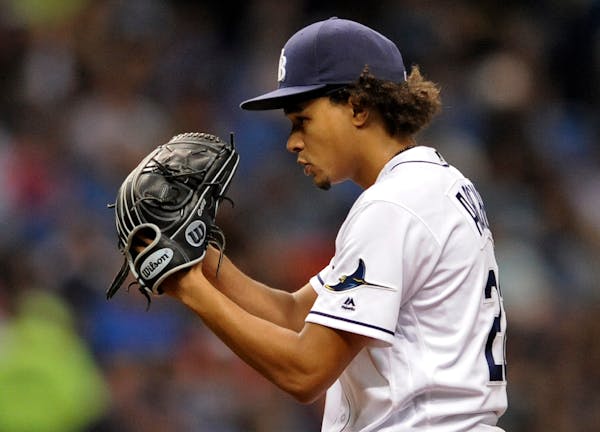FORT MYERS, FLA. – Garvin Alston has a brown leather notebook cover that is stuffed with notes on pitchers and pitches.
"This baby has been with me since 2012," the new Twins pitching coach said Monday.
Pages, in different colors, stick out of the sides. When Alston holds it, he looks like a disorganized student who's late for an exam.
Fellow Twins coach Jeff Pickler makes fun of it. "You know," Pickler said to Alston, "we have databases for all this."
Alston, 46, likes writing things down and diving into the book. That's what works for him. And that's the mantra he is going by in his first season as a major league pitching coach, with Twins pitchers and catchers reporting to camp Tuesday.
Alston is going to help each of the pitchers realize what works for them, then use that knowledge to try to shut down hitters.
"Hopefully these guys are open to it," he said. "You can have the best information that you can, but if they are not open to receiving it, it means absolutely nothing."
They should be. The Twins were 19th in the majors last season with a 4.59 ERA, 24th with 62 quality starts (at least six innings pitched, three or fewer runs) and 26th with a .266 batting average against. They have been unable to upgrade the starting rotation, and staff ace Ervin Santana is expected to miss up to the first month of the season following middle finger surgery.
Alston was hired Oct. 22, replacing the fired Neil Allen. Since then, Alston has learned about as many of his new pitchers as possible by swapping texts, having phone conversations and watching film. Last month's TwinsFest enabled him to meet many for the first time and open a dialogue.
"I was watching film an hour, hour and a half a day, on different guys," said Alston, who was the Oakland bullpen coach last season. "I tried to set it up to where it was two guys a day and just look for different things I've been taught, and write little notes down here."
He surfs through social media to see what his players are up to. He was asked if he saw the workout video of Jose Berrios that was posted on Twitter — the one of the young rising star pushing a truck.
"I'll just say this," Alston said with a chuckle. "I've seen video of him pushing trucks. I've seen video of him throwing bullpens too early, when I had to pick up the phone and give him a call.
"He's going to be fine. He's just an eager bull, ready to take the horns and go to work."
He has spoken to reliever Ryan Pressly, who had a 4.70 ERA last year and gave up a career-high 10 home runs. Pressly can throw a fastball 95 miles per hour and has a good breaking ball, but he was unable to put it all together in 2017.
"I hope he understands that he has to use his fastball, but it's the question of how much he needs to use his fastball," Alston said. "I think the experience he went through last year can only help him this year."
Pressly sounded excited as he talked about what Alston suggested.
"I'm all ears," Pressly said.
Last month, Alston even met with fellow Phoenix-area resident Aaron Slegers to watch the 6-foot-10 righthander throw and offer some pointers on mechanics. Slegers throws across his body at times, making it hard to spot his fastball.
"He had some good things to say and gave me some stuff to work on," Slegers said. "I've got long limbs, and keeping that toward the plate is important. Straight line to home plate. I'm constantly battling that."
Monday, Alston stood behind Phil Hughes as the veteran righthander threw in the bullpen at Hammond Stadium. Hughes is trying to revive a career that has been derailed in each of the past two seasons by surgery to correct thoracic outlet syndrome. The two discussed mechanics and possibly changing where he stands on the pitching rubber, but Alston stressed that Hughes has to be comfortable with any change for it to work.
Alston is learning what he has to work with. In turn, he wants pitchers to discover what works for them — then he can help build a competitive staff.
"You will hear me say this a lot — 'Who are you?' " he said. "I try to identify every person so they can understand who they are. Once they figure that out, my job is to guide them. But they have to understand what they can do and what they can't do.
" 'I don't know who I am' is actually a normal answer."
French athletes at Paris Olympics will receive better mental health protection
Chinese Grand Prix could deliver drama to F1 and slow Verstappen's victory march
NFL draft will include many Michigan men, maybe enough to break record set by 2022 Georgia Bulldogs

